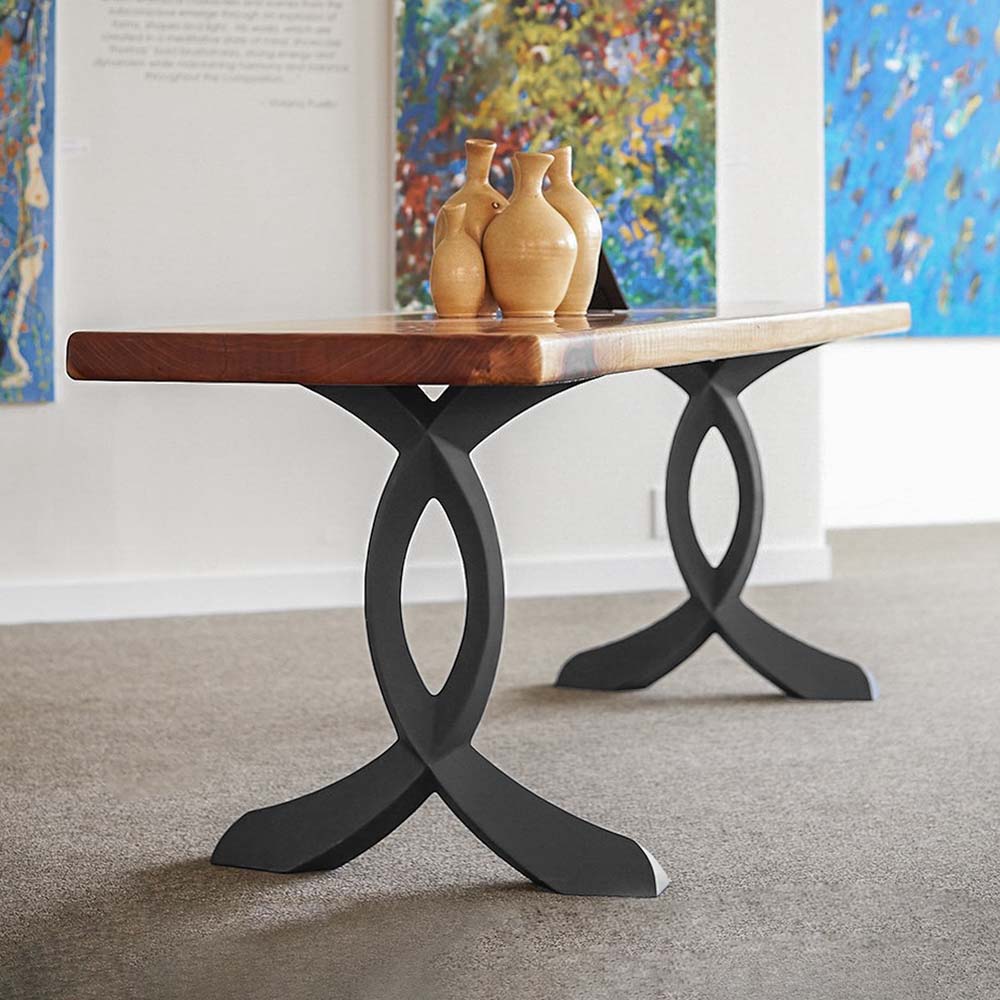A Thorough Consider Dining Table Leg Styles: Locating the Ideal Match
Picking the right table leg style is critical for both aesthetic charm and useful performance. Traditional four legs provide ageless elegance and stability, while the pedestal base gives boosted legroom and a modern-day appearance. For those with larger tables, trestle legs guarantee sturdy assistance, whereas barrette legs present a mid-century modern ambiance with their minimalist design. The x-shaped legs mix contemporary design with improved stability. Each of these options brings one-of-a-kind advantages, making the option more than just a matter of preference. Explore further to uncover which style perfectly complements your dining area and way of life.
Standard Four Legs
Among the different sorts of table leg designs, the conventional four-leg style remains a classic selection for numerous homes. This classic configuration provides a harmonious mix of performance and looks, making it a perennial fave. Four legs provide well balanced assistance, making certain the table stays stable and with the ability of bearing significant weight. This is especially helpful for homes that regularly organize big events or utilize their eating table for several purposes, such as job or crafting.
From a visual point of view, the standard four-leg design can be conveniently adjusted to various indoor designs. Whether crafted from wood, metal, or a combination of materials, these legs can be elaborately sculpted, streamlined and minimalistic, or anything in between. Their flexibility enables them to match both rustic and contemporary setups flawlessly.
In addition, the simple structure of the four-leg style assists in convenience of movement and placement within a space. Unlike even more complex bases, this design lessens blockages, providing adequate legroom for diners. In summary, the standard four-leg table leg design weds enduring sophistication with functional functionality, making it an astute option for those seeking both kind and feature in their dining furnishings.
Stand Base
Typically commemorated for its stylish and space-efficient style, the stand base is a recognized choice to the traditional four-leg arrangement in table leg styles. This distinct base commonly features a solitary main column sustaining the table top, which can differ in kind, from ornately carved wood to sleek, modern metal. Among the key advantages of the stand base is its ability to optimize legroom and seating versatility. Without edge legs, diners are managed better flexibility of motion, making it an ideal selection for round and oval tables that advertise more intimate and inclusive gatherings.
Moreover, the pedestal base's central assistance can take care of significant weight, permitting for making use of much heavier table tops, such as marble or thick hardwood. This strength combined with its aesthetic convenience makes the stand base a prominent selection in both standard and modern interior settings. It can seamlessly incorporate with various layout styles, from traditional elegance to minimal modernity. weblink The central column itself provides a canvas for detailed styles and artistic expressions, including a component of visual rate of interest underneath the table. In summary, the stand base integrates capability snappy, making it a fine-tuned hop over to here and useful option for varied eating atmospheres.
Trestle Legs
Trestle legs give a durable and timeless structure for eating tables, identified by their horizontal cross-bracing and sturdy support light beams. Originating from middle ages times, this layout has actually advanced yet preserved its vital structure, making it a seasonal favorite in both traditional and modern settings. The main trestle light beam, typically sustained by 2 or even more vertical posts, uses exceptional security, enabling for larger table sizes without the need for extra legs.
A significant benefit of trestle leg tables is the sufficient legroom they supply. Unlike tables with four corner legs, the lack of blockages at the table's sides offers unblocked space for chairs and restaurants, boosting convenience and ease of access. This makes trestle tables excellent for fitting bigger gatherings, whether in a dining-room or a banquet hall.
The visual convenience of description trestle legs is significant. Available in a variety of products such as wood, steel, and composite, they can be ended up to enhance a wide variety of indoor designs. From rustic farmhouse to streamlined modern-day styles, trestle legs can be personalized to suit individual preferences. Their long-lasting allure and functional benefits make trestle legs a compelling option for those seeking both design and functionality in their table.
Barrette Legs

The allure of barrette legs lies in their simplicity and flexibility - dining room table legs. Offered in a variety of materials, consisting of steel and brass, they can be finished in countless shades to match different indoor styles. Whether coupled with a rustic wood table top or a contemporary glass surface area, hairpin legs easily blend capability with a touch of classic appeal
Toughness is another notable attribute of barrette legs. Regardless of their fragile look, these legs are crafted to birth significant weight, making certain the dining table stays steady and protected. Furthermore, they are reasonably simple to install, making them a popular choice for do it yourself fanatics and specialist furnishings manufacturers alike.
X-Shaped Legs

Constructed from products such as steel, timber, or a combination of both, X-shaped legs can be tailored to match numerous layout choices. Steel legs frequently offer a smooth and industrial feeling, perfect for loft-style apartments and modern dining areas.
Additionally, the design behind X-shaped legs ensures also weight distribution, lessening the risk of wobbling and enhancing resilience. This makes them especially well-suited for bigger dining tables that need extra assistance. Essentially, X-shaped legs blend useful design with contemporary appearances, making them a timeless option for diverse dining environments.
Conclusion
A thorough understanding of eating table leg designs exposes the distinctive attributes and advantages of each style. Trestle legs guarantee durable support for bigger tables, and barrette legs introduce a mid-century modern-day aesthetic.